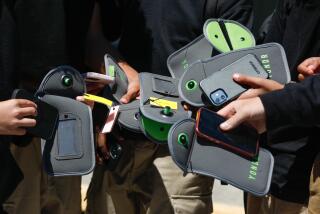Teacher finds a way to keep kids on track amid classroom tech distractions
- Share via
Teachers have always faced the challenge of grabbing and maintaining students’ attention, but that task arguably reached a high point with the introduction of electronic equipment in class.
Beginning in October 2014, the Laguna Beach Unified School District rolled out a staggered bring-your-own-device program in which fifth-grade, middle and high school students could either bring a personal computer to class or use a district Chromebook to complete assignments.
The policy has resulted in students collaborating, in real-time, on creating multimedia projects that incorporate text, graphics and photos — tasks that district staff and teachers said mirror duties their future jobs will require.
But it also introduced a complication for teachers, who must ensure that students don’t veer off task when tempted by a keyboard and screen only inches away.
This has led the district to refine its policy on the use of electronic equipment in class, which prohibits the posting of harmful or inappropriate content that is threatening or obscene. The subject was also discussed at the March 8 school board meeting.
Mark Alvarez, an Advanced Placement economics and government teacher at Laguna Beach High School, thinks he has at least a partial answer. And district officials agree.
In addition to roaming among desks to monitor his students, Alvarez has incorporated a web app called Pear Deck, which synchronizes a presentation on his screen with screens of his students. When Alvarez changes slides, the slides also shift on the students’ screens.
He engages students by typing questions they can see on their screens. Students provide written responses and, at the end of class, Alvarez can see which students participated.
“[Twelve years ago] they would look out the window or draw a picture in their notes,” said Alvarez, who started at the school 12 years ago, about student attention spans. “Kids are more or less the same. The technology has changed.
“Back then, if a kid was not engaged, he or she would latch on to another kid. Now it’s a much more autonomous experience.”
District staff educated teachers on Pear Deck in September, and 118 — or 70% of district instructors— are using the program, said Mike Morrison, Laguna Beach Unified’s chief technology officer.
“The engagement of students is something that we will continue to work on and refine internally,” Morrison wrote in an email. “It is part of any [bring-your-own-device] roll-out that teachers learn new techniques to better manage the new learning tools in their classroom.”
The district blocks students from accessing Facebook and other sites, such as those containing pornographic material, by installing filters on its wi-fi system, Morrison said.
If a student doesn’t have a personal computer, he or she can check out a Chromebook for a class or longer duration if needed.
Parent Sheri Morgan advocated for exclusive use of Chromebooks in classrooms instead of students being allowed to bring their own computers at the March 8 meeting, saying the allure of online shopping and gaming can be distracting.
While Chromebooks allow students access to the Internet, Google’s Chrome operating system allows teachers to monitor the screens of students using the laptops.
“With the Chromebooks, the teachers can access and see what the kids are studying,” Morgan said. “Some way to get the teachers more power to teach and less time to have to baby-sit because it’s becoming a huge problem to the fact that our kids aren’t learning.”
Morgan has seen the benefit of incorporating technology into classroom assignments. Her third-grade daughter and classmates recently worked on a play at home.
“They were all in Google docs writing a play at the same time,” Morgan said. “You could see who was writing, and they also had a chat screen. To me, that was technology at its finest.”
Students can complete all required assignments with Chromebooks, but Morrison added that personal computers could be advantageous for more advanced projects, such as video editing.
District staff and principals discussed the idea of moving solely to Chromebooks but decided against that route, Supt. Sherine Smith said during the meeting.
“Students are very adept at using technology and they could find a way to do the same thing on a Chromebook. It’s their native language,” Smith said. “It’s incumbent upon the teachers to have very engaging lessons because then students aren’t as apt to be distracted or go off and access other things.”
Alvarez doesn’t blame technology as the reason a student could be distracted.
“It’s not technology’s fault there is something going on with a student who does not want to learn,” Alvarez said.
More to Read
Sign up for Essential California
The most important California stories and recommendations in your inbox every morning.
You may occasionally receive promotional content from the Los Angeles Times.










